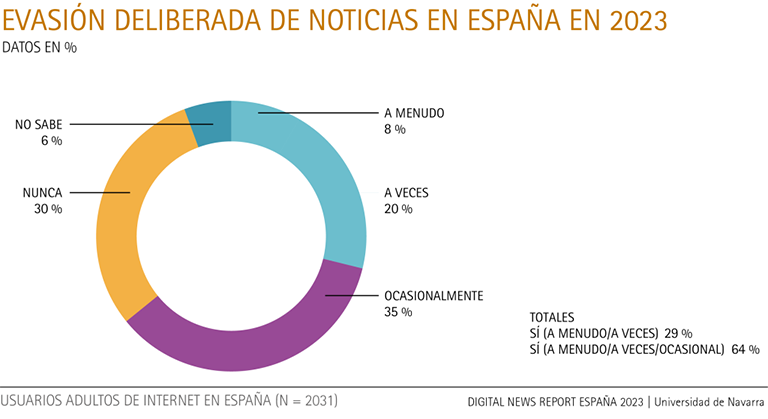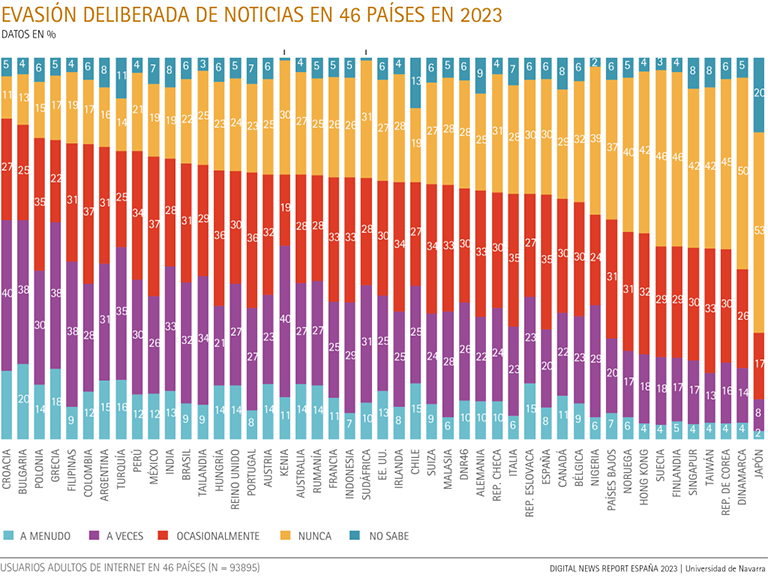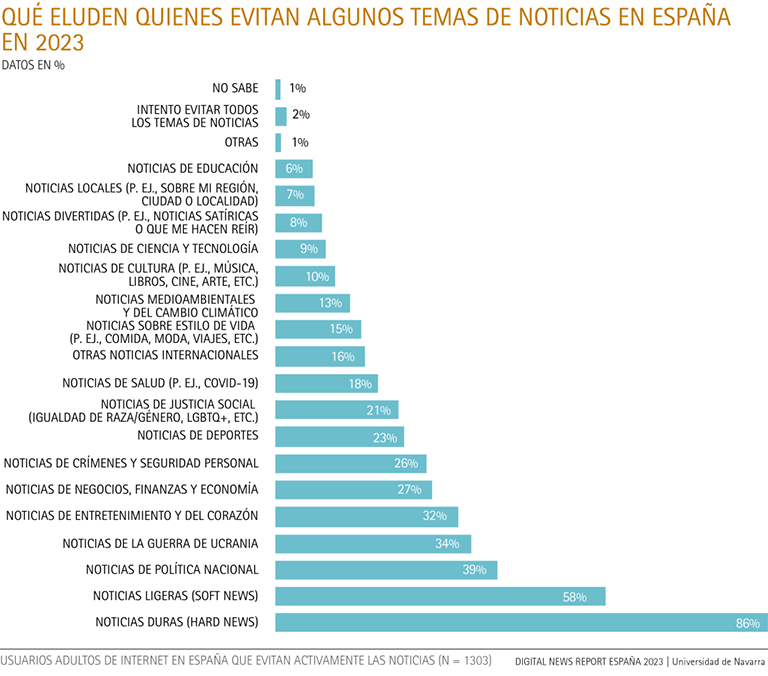-
Women aged 45 to 54 are the main "news avoiders" (74%), while men over 55 never avoid current affairs (44%).
-
Seven out of ten women aged 25-34 have reduced their frequency of access to news (67%), as have six out of ten 18-24 year olds (63%).
-
Four out of ten 18-24 year olds prioritize activities that do not involve the news (39%) and three out of ten ignore, skip or change the channel when watching the news (33%).
-
Six out of ten users who avoid news dispense with politics, Ukraine, weather or health (65%).
Deliberate news avoidance continues to contribute to creating Internet users who are disconnected from journalism. The challenge of establishing or strengthening engagement with different generations of audiences remains, although active avoidance slows down in 2023. Six out of ten Spanish respondents actively avoid checking the news according to the Degree of often, sometimes or occasionally (64%). This is 5 percentage points less than last year. Moreover, this figure is slightly lower compared to average of the 46 countries analyzed (66%). In particular, three out of ten respondents in Spain often or sometimes avoid current affairs (29%) and one out of ten often (8%). This is 7 points less in the first case and 2 points less in the second case when compared to the global average . Only three out of ten Spaniards never avoid the news (30%), in line with the average of the 46 countries (28%).


More evasion among the public under 45 years of age
The audience under 45 years of age is the one that promotes active news avoidance in Spain: seven out of ten according to the Degree of often, sometimes or occasionally (68%). However, this habit and Degree is also relevant for seven out of ten adults aged 45 to 54 (71%). In any case, deliberate avoidance of current affairs drops among adults aged 35 to 44 (69%) and young people aged 18 to 24 (65%). This internship leave 9 points in the first case and 13 points in the second compared to last year. Despite this, one in ten people under the age of 45 often skips information (10%). For their part, users over 55 remain the group of reference letter that never skips news: four out of ten (38%).
Due to their greater interest, men continue to differentiate themselves by not avoiding the news: three out of ten never avoid it (34%). This is a 7 percentage point difference compared to women. In contrast, seven out of ten women reject the news according to the Degree of often, sometimes or occasionally (67%). That's 6 points more than them. However, only three women out of ten often or sometimes avoid information (30%) and this level of active avoidance is down 9 points on reference letter compared to last year.
Combining age range and gender, grade also shows that adult women aged 45 to 54 are the group most likely to avoid the news often, sometimes or occasionally: seven out of ten (74%). This is 6 percentage points above men in this age range. On the other hand, adult women aged 55 to 64 stand out for not dodging information: three in ten never do so (34%). However, this loyalty is lower than that of the segment that never avoids news: men aged 55 and older (44%). In this context, women under 35 years of age are slowing down their use of news avoidance, with seven out of ten using it in 2023 (66%) compared to eight out of ten in 2022 (80%). In particular, three out of ten of those under 35 years of age often or sometimes (30%) reject current affairs. This is 20 points less than in the previous year.
Users with lower income and low level educational
Deliberate news avoidance remains positively related to respondents with lower economic and educational qualifications. Seven out of ten internet users with income leave actively avoid checking the news according to the Degree of often, sometimes or occasionally (67%). This link weakens in 2023 as it is 10 percentage points less than last year. Despite this, there is still a difference of 6 points compared to people with a high income and 3 points compared to those with an income average. This means that four out of ten high-income users never shy away from information (37%). This is 10 points more when compared to those with an income of leave and 7 points more when compared to those with a medium income.
Similarly, seven out of ten Internet users with a low level of educational actively evade according to the Degree of often, sometimes or occasionally (66%). This is 7 percentage points less than in the previous year. However, in 2023, a difference of 3 points remains with respect to people with a high educational level and 4 points with respect to those with a medium level. As a result, four out of ten users with a low level educational occasionally skip the news (38%). On the other hand, three out of ten users with a high educational level (33%) and with a medium educational level (32%) never avoid news.
Right-wing affinity and disinterest in politics
Audiences on the political right exercise deliberate avoidance of news to a greater extent. Seven out of ten according to the Degree of often, sometimes or occasionally (67%). There is a percentage difference of 5 points between, on the one hand, people in the center (62%) and, on the other hand, those who do not know how to define themselves politically (62%). Thus, three out of ten right-wing respondents reject information frequently or sometimes (33%) and one out of ten frequently (13%). On the other hand, three out of ten Internet users from the political center never avoid them (34%). For their part, two out of ten of those who declare themselves to be leftists sometimes ignore the news (23%). Moreover, in 2023, it is significant that the number of people who avoid the news and who do not know how to identify themselves politically (13 points less than last year) is decreasing. Despite this, three out of ten of these users often or sometimes avoid the news (31%).
Active avoidance of the news is also linked to disinterest in politics. Seven out of ten people who often, sometimes or occasionally turn away do not appreciate politics (70%). On the other hand, four out of ten of those who never turn away from the news have a high or very high regard for politics (45%).
Finally, and logically, respondents who avoid the news according to Degree often, sometimes or occasionally consult the news less frequently. Seven out of ten several times a week (72%). This is 8 percentage points above the average. On the other hand, three out of ten users who never skip information consult it several times a day (34%). In particular, 6 to 10 times.
Types and modes of news evasion
Half of the Internet users who actively avoid consulting the news follow two main behaviors: reducing the frequency of access (49%) and avoiding sources (46%). This behavior of Spaniards is similar to that of the 46 countries average both in the first case (50%) and in the second case (48%).
When deliberate avoidance is related to interest in news and interest in politics, two types of patterns or types of avoidance linked to the behaviors described above are observed. On the one hand, half of the Spanish users disinterested in the news engage in indiscriminate or periodic avoidance of sources (52%). patron saint This is almost similar to the average of the 46 countries (55%). Unlike other more polarized socio-political contexts, these users in Spain are very interested in politics (53%). This coincides with the global average (52%).
On the other hand, half of the Spanish Internet users extremely or very interested in news develop a selective or specific avoidance by reducing the frequency of access (47%) and certain topics. A internship that goes below the global average (52%). This subject of Internet users differ by being somewhat interested in politics (52%) compared to the global average which is extremely interested (56%).
In this framework, specific modes of active avoidance are avoiding certain news topics (31%), avoiding certain media (e.g., TV news, newspapers or websites) (26%), checking news media less frequently (25%), prioritizing activities that do not involve news (23%), and ignoring, fast-forwarding or changing the channel when I watch news (22%). To a lesser extent, avoiding news at certain times of the day (e.g., when getting up in the morning or before going to bed at night) (19%), turning off or reducing notifications (e.g., on my cell phone) (17%), and avoiding places or situations where news might appear (10%).

Audiences under 35 years of age are the main group news "avoiders". On the one hand, six out of ten of these people have decreased the frequency of access (61%). In particular, women aged 25 to 34 (67%) and young people aged 18 to 24 (63%). On the other hand, five out of ten people under the age of 35 who avoid the news avoid the sources (54%). Specifically, half of 18-24 year olds (55%), as well as men (50%) (8 percentage points more than women). The behavior of people under 35 years of age moves between selective or specific evasion and indiscriminate or periodic evasion. In particular, these users consult sources less frequently (31%), prioritize activities that do not involve news (29%), ignore, quickly pass or change the channel when they see news (27%) and deactivate or reduce notifications (for example, on their mobile) (26%). Notably, four in ten 18-24 year olds who avoid news favor activities that do not involve news (39%); and three in ten ignore, quickly swipe or change the channel when watching news (33%).
Likewise, selective or specific evasion and indiscriminate or periodic evasion are detected when considering other sociodemographic variables.
When combining age group and gender, men who avoid news stand out for avoiding certain media (e.g., television news, newspapers or websites): three out of ten (29%). Above all, those over 55 years of age (34%). They also deactivate or reduce notifications (e.g., on their cell phone) (20%); and avoid places or situations where they know news may appear (12%). For their part, women who avoid news below the age of 35 encourage activities that do not involve current affairs: three out of ten (34%). In addition, those aged 25 to 34 consult the media less frequently: three out of ten (35%).
Similarly, half of the respondents who avoid news and have a high income are less likely to access news less frequently (52%) and avoid sources (53%). In this case, three out of ten of these people prefer activities that do not involve news (29%). This behavior is 11 percentage points above those with an income leave.
In turn, Internet users who avoid news and have a high level of educational also use news less frequently (52%) and avoid sources (52%). Specifically, three out of ten consult the news media less frequently (29%) and engage in activities that do not involve current affairs (28%). In addition, two out of ten deactivate or reduce notifications (e.g. on their cell phones) (19%). A decision applied by users with an average level educational (20%).
Regarding the political inclination of the public that avoids news, half of those who claim to be in the center mean to reduce the frequency of access (52%). This behavior reflects a certain selective or specific avoidance. As a result, three out of ten of these Internet users consult the news media less frequently (27%). On the other hand, the public on the right is more likely to avoid certain media (e.g., television news, newspapers or websites): three out of ten (31%). The same behavior is observed among those who declare themselves on the left, but to a lesser extent (28%).
Precisely, politics appeals totally or very much to three out of ten users who shy away from certain media (e.g. TV news, newspapers or websites) (35%). In addition, a certain information fatigue is perceived because two out of ten people who have deactivated or reduced notifications (e.g. on cell phones) are totally, very much or slightly interested in politics (20%). Unsurprisingly, three in ten respondents who prioritize activities that do not involve news also do not appreciate politics (29%). The same is true for two in ten of those who ignore, fast forward or change the channel when watching news (25%).
Finally, and naturally, six out of ten users who have reduced the frequency of access to the news consult them several times a week (59%). For their part, half of those who circumvent the sources turn to the news six to ten times a day (50%), as well as several times a week (51%).
Hard news avoidance
Internet users who avoid current affairs mainly avoid so-calledhard news: eight out of ten (86%) as in the 46 countries (87%). In Spain, they mainly avoid national politics (39%), the war in Ukraine (34%), and business, finance and Economics (27%). It is relevant that six out of ten of these users reject information on politics, Ukraine, climate or health (65%).
In contrast, only one in ten of the respondents who avoid news shy away from local information (e.g., about my region, city or town) (7%). Therefore, local information continues to interest the public and remains a social value. On the other hand, what is known assoft news is avoided to a lesser extent: by six out of ten Internet users who avoid information (58%). This is 5 percentage points more than average for the 46 countries. Mainly entertainment and heart topics (32%), sports (23%) or lifestyle (e.g. food, fashion, travel, etc.) (15%) are avoided.

Hard news is avoided by nearly the entire audience under 45 years of age who avoid current affairs(89%). In particular, business, finance and Economics (31%), health (e.g. COVID-19) (22%), and environment and climate change (17%). In contrast, six out of ten adults over 55 years of age skimsoft news (65%). Mostly, entertainment and heart (41%), and sports (26%).
When specifying gender, eight out of ten men who avoid current affairs avoidhard news (83%) (5 percentage points less than women). As a result, they avoid lifestyle (22%) or culture (15%) topics. Specifically, 12 points more in the first case and 8 points more in the second. However, men are more likely to avoid environmental and climate change issues (17%) than women (10%). On the other hand, women who avoid news reject national politics (44%), and business, finance and Economics (33%). In both cases, they are 12 points more than men. Thus, seven out of ten of these women shy away from information on politics, Ukraine, weather or health (69%). To a lesser extent, Degree, sports (28%) (13 points more than men).
This trend of deliberate avoidance by subject of news is enhanced when combining age and gender. Thus, four out of ten men aged 35 and over avoid news about entertainment and the heart (41%). Likewise, two out of ten of these men avoid lifestyle topics (22%), environment and climate change (16%), culture (14%) and Education (11%). On the other hand, four out of ten women aged 35 and older ignore national politics (44%). In addition, three out of ten of them shy away from crime and security issues staff (30%), business, finance and Economics (29%), and sports (29%).
Likewise, B shows that the majority of respondents who avoid news and have a high level of educational avoidhard news (89%). This is 6 percentage points above those with less programs of study. In particular, users with high educational level reject information about social justice (race/gender equality, LGBTQ+, etc.) (25%), health (e.g., COVID-19) (21%), and environment and climate change (16%).
Similarly, there is a direct relationship between disinterest in politics and active avoidance of related topics. Thus, seven out of ten Internet users who do not appreciate politics avoid information on politics, Ukraine or climate (67%). This habit is 6 percentage points higher than average. Moreover, there is a difference of 14 points compared to those who are extremely or very interested. Disinterest in politics also influences avoidance of issues about business, finance and Economics (36%), lifestyle (e.g., food, fashion, travel, etc.) (25%), international (22%), and science and technology (14%). However, appreciation of politics causes two in ten extremely or very interested people to shy away from lifestyle topics (e.g., food, fashion, travel, etc.) (25%).
Finally, respondents who avoid entertainment and heart news (38%), and social justice (race, gender, equality, LGBTQ+) (26%) stand out for accessing news at a higher frequency: two to five times a day. However, those who avoid science and technology issues check the news once a day (12%).